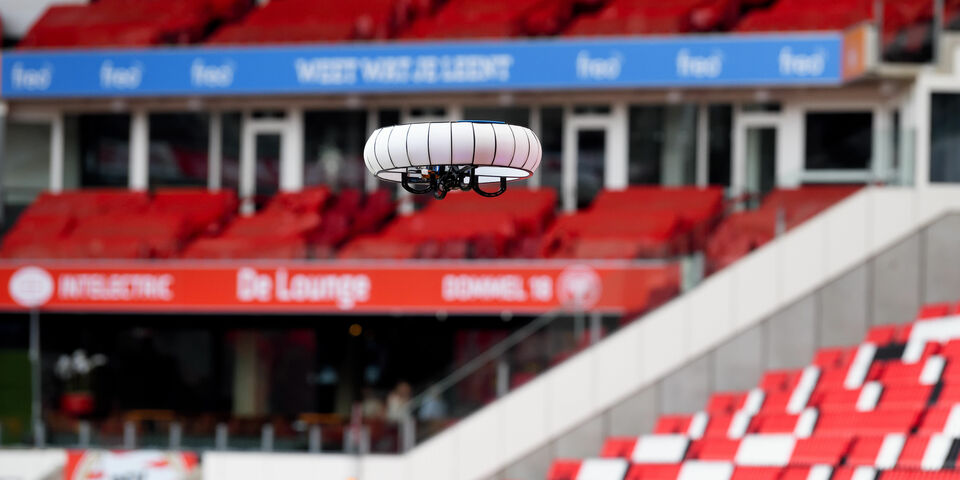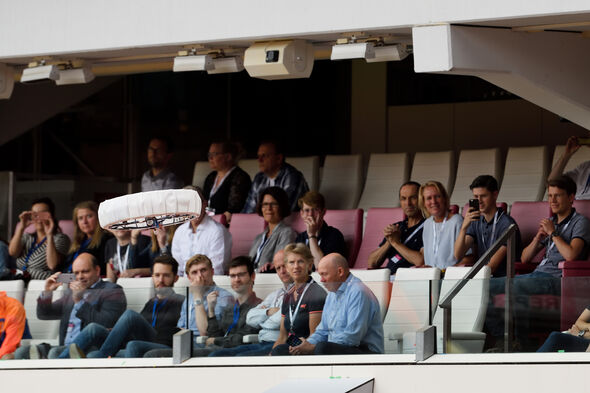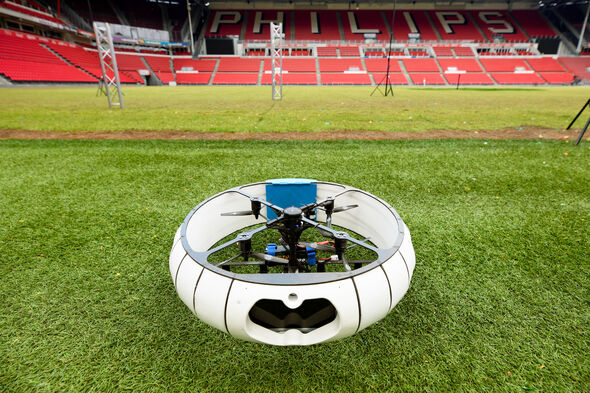Blue Jay introduces autonomous drone in football stadium
If it were up to the drones of student team Blue Jay, the Philips Stadion will be even safer in the future. The team is working on a safety and security drone that will be able, for example, to spot someone who fell to the ground. During a presentation in PSV’s home turf last Friday, Blue Jay showed the world what it has accomplished this year with drones 4.1, 4.2 and 4.3.
Student team Blue Jay has an (almost) completely different team composition each year. A new team comes up with new goals after spending a transition week with the old team. This year, they decided to improve the technology and to make the drones lighter and more efficient. Now, the team is ready to show their friends, business partners and the media how far they have come in one year.
Team member Emmie Schoutens explains how her team ended up in the Philips Stadion. “During brainstorm sessions with the TU/e fire department, we were looking for the best and most useful ways for drones to make a contribution to society. Through contacts with the fire department, the ball started rolling in the direction of the Philips Stadion. We talked to the stadium manager and came up with the current collaboration in consultation with him and the regional fire department.” Philips and the Philips Stadium facilitate Blue Jay’s tests, and the emergency services indicate the need.
The ambition is quite serious: by 2022, an autonomous safety and security drone produced by Blue Jay will be able to fly over and inside the Philips Stadion and detect emergencies, such as a riot or a wounded person, react to this, and inform personnel via an app. That is what Paul van Dooren, advisor repression and innovation at the fire department of Brabant-Zuidoost, expects. He has been following Blue Jay for some time now and held a short opening speech, dressed in uniform, last Friday.
“Blue Jay made the first indoor drone that can do more than the current tools. The drone can keep track of someone in the stands of a stadium. With the current cameras, we constantly need to switch to the next image. The drone uses Artificial Intelligence to detect suspect appearances and behavior. Perhaps someone is carrying fireworks, or a fight might break out. Or it detects smoke curling up. Or perhaps someone with a stadium ban managed to get it. When someone stands still while the rest moves on, it might indicate that he or she feels unwell. A drooping mouth might indicate that a person is suffering a stroke,” Van Dooren says. “My vision of the future is that the drone communicates with the person who needs help and then informs the command room to send an actual steward to come and help.”
Live show
But we haven’t reached that point yet. During the presentation on the pitch, the student team shows the differences between the three drones they developed this year. The first drone is the heaviest and can cover the shortest distance, but only an expert could see the differences. Team leader Rik Benoist explains: “The second drone (4.2) has ten percent less weight, or three hundred grams. That could result in one minute of extra flight time. The third drone is much more efficient because we changed the position of the engines.”
The person who came up with that idea is team member Lars Zender. His role is that of pilot during the presentation, up to the moment that the drone starts to fly autonomously and Lars can wave to the audience with both hands. Lars: “The engines were placed on the bottom of the drone, not far from the propeller. The drone has to go up and the air has to circulate downwards. I realized that if that air flow could cover a shorter distance, it would result in more efficiency. We managed to reduce that distance by placing the engines higher in the drone.” Because it is made out of a different material and has a more robust landing gear, the third drone (4.3) is a bit heavier, but it can remain airborne using less energy.
The presentation is the festive conclusion of a year full of hard work. Roel Wessels, external team management trainer, describes it this way: “I’m proud of these students. They have accomplished so much in one year. I talked to them once every two weeks and insisted that they should take the initiative, especially when things didn’t go according to plan, and that they should remain focused. And, referring to speed skater Sven Kramer who said that he wasn’t going to skate ten kilometers but four hundred meters twenty-five times over, I told them that they weren’t going to work an entire year, but forty times a week. And today, they present their drone to the world.”




Discussion